Pamukkale, Turkey - The Eighth Wonder Of The World - Myth Or Reality?

Since I've already written a few blogs about Turkey, I want to try and tell you what we've seen during our previous visits to this wonderful country. And of course, firstly, it's Pamukkale.

We always want that any of our trip will remain in our memory for many years. We all know about the seven wonders of the world. But why only seven? There are only these interesting places in the whole world that we could call wonders? I think there are many more. And one of them is Pamukkale in Turkey. But there is one difference.
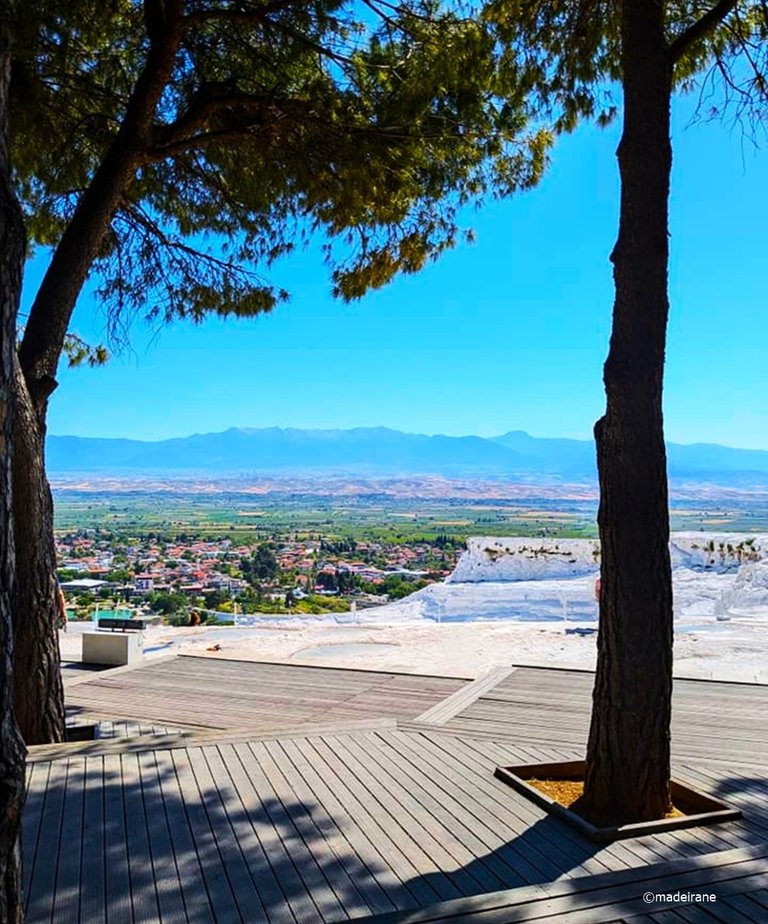
The world-recognized wonders of the world were created by human hands and, for this very reason, were ranked among the creations with an inexplicable origin, bordering on the limits of human capabilities. Man is a creator of unlimited possibilities. It is unlikely that anyone can repeat this again, but what Nature herself, who gave birth to man, can do is beyond comprehension.

My first excursion inside Turkey was a trip to an incredibly beautiful and fascinating place in the province of Denizli, located 250 km from Antalya, with a mysterious and tempting to visit name Pamukkale.
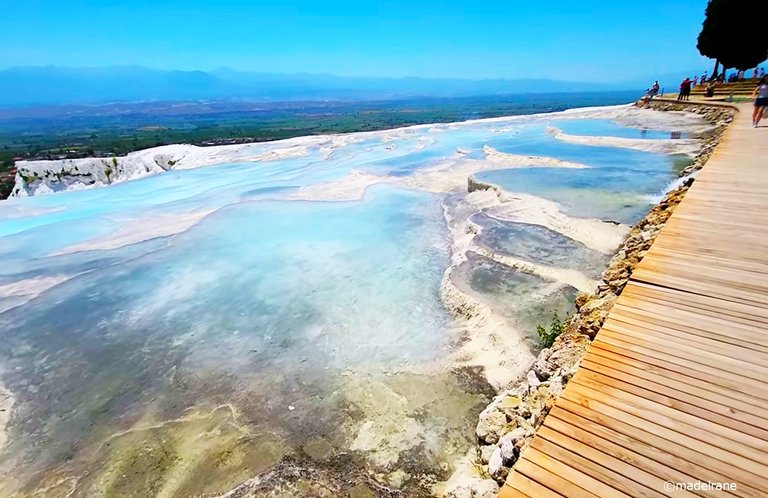
Pamukkale is an unique natural treasure, included in the list of UNESCO World Heritage Sites. The thermal springs in the area with an excess of white limestone (calcium carbonate) in their composition gave the hill its national name - Cotton Mountain. This area of unearthly beauty is able to give good health and has long been considered a resort for lovers of fantastic exotic beauty. Currently, Pamukkale is the most visited and favorite place for tourists of all nationalities, but not only because of its uniqueness. This place is famous for three attractions at once in one small area, not including Pamukkale - Cleopatra's Pool and the ruins of the ancient city of Hierapolis destroyed by time and historical events. It is impossible to convey the impressions of what you saw live.

The location of the attraction is not the most convenient for tourists, it is quite far from the seaside resorts by excursion standards, which entails a number of inconveniences and disadvantages. Departure early in the morning, since it is a long way to go and at midday there is unbearable heat from which you can earn yourself a sunstroke, the travel time to the site and back is about 5-7 hours, everything will depend on the traffic congestion and the well-being of the excursionists.

The Turks are greatly protecting and guarding their attractions. Anyone can take the tour, but without shoes, barefoot. The uniqueness is worth it. Something unusually beautiful and captivating awaited me, captivating the spirit. There are not enough words to describe my feelings that I experienced when visiting this unique place with its beauty and unique origin. Every time when I look at these photos, I am amazed by the majesty of nature.
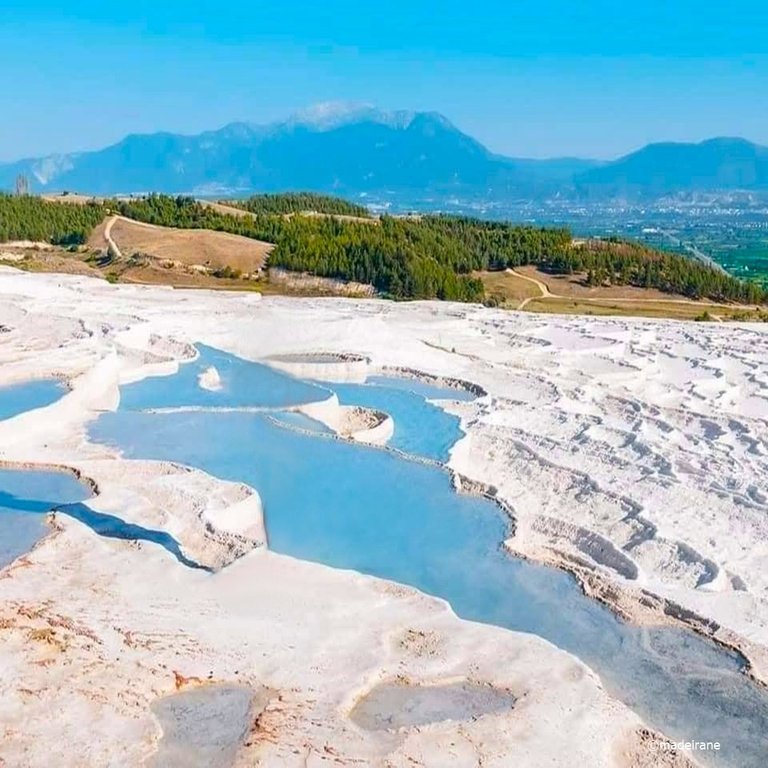
Water rises to the surface from a depth of 9 km. It contains carbon dioxide and calcium salts. Carbon dioxide evaporates and white deposits of calcium carbonate remain. In fact, these are limescale deposits.
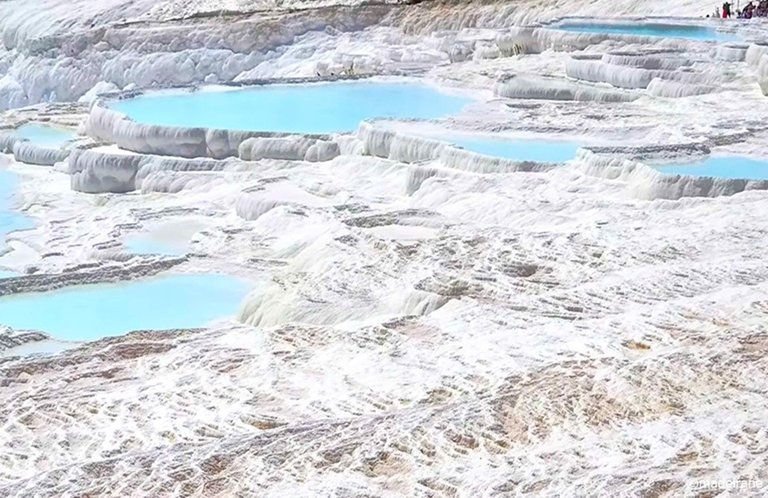
The Pamukkale terraced ponds are rightly called the failed eighth wonder of the world. Approaching them from afar, you get the feeling that among the endless greenery, there is real snow on the ground! It is like I found myself as if in a winter kingdom, shackled by the hot May sun. The visual snow around you under the babbling springs are quite comparable to these beautiful views of wild unbridled nature.
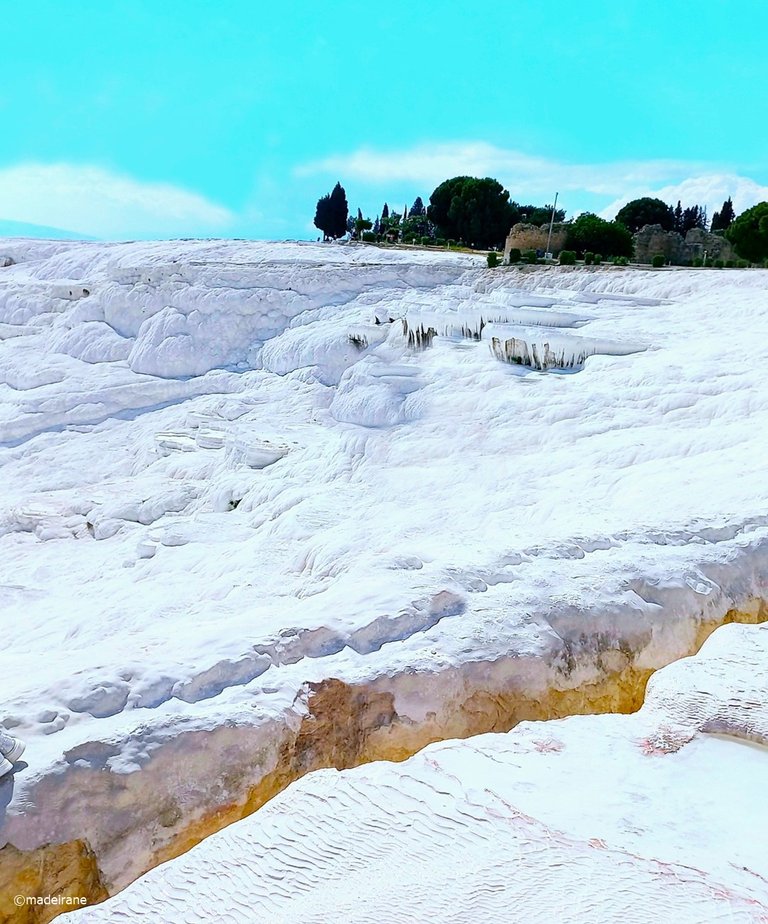
The water in this part runs along it in a practically continuous stream, and the lower you go, the more clearly the limestone deposits begin to appear, with bluish-tinted pools of water. Water, as we know, wears away stone, which is also reflected here. The correct geometric shape of the reservoirs fascinates tourists with its beauty.
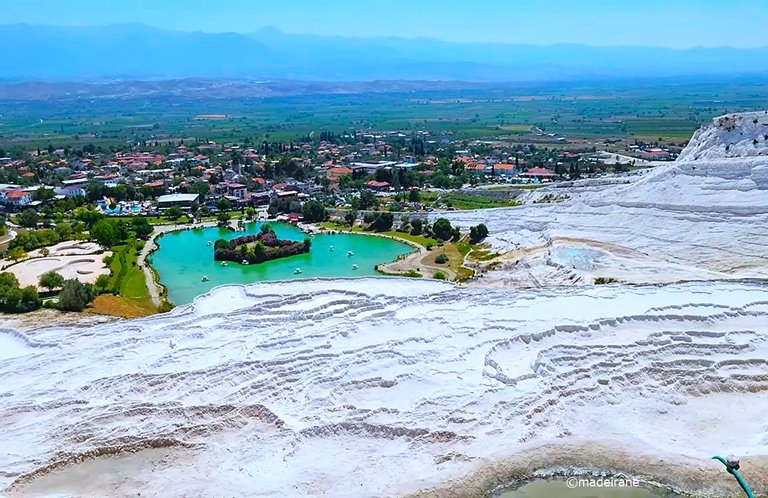
Soon, the most beautiful, postcard views of round terraces with stalactites along the edges opened up to our eyes. What beauty! These round terraces are on the other side from the beginning of the descent. When we visited Pamukkale, we could still enter them, but now, as I heard, the entrance to them is closed, and you can only admire them from the side.
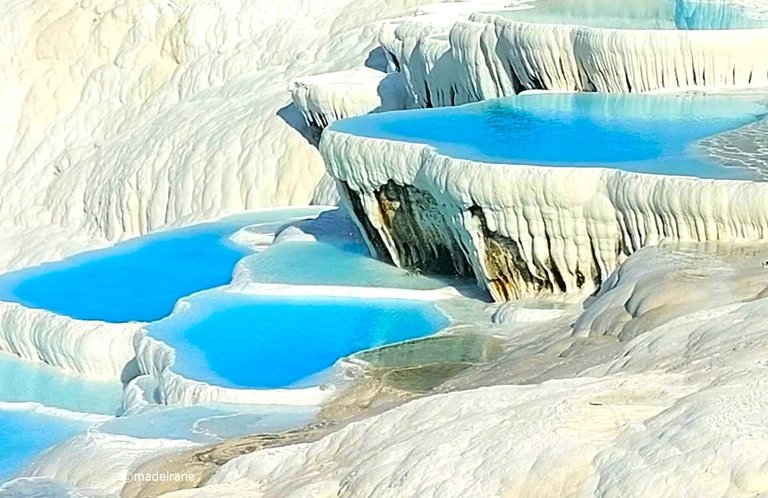

The lime slime on the surface is very slippery, and the many channels through which fast streams flow also do not allow you to move along them on foot. For that, they are of unearthly beauty. You can admire them endlessly. The closer you move down, the more streams there are on the surface.
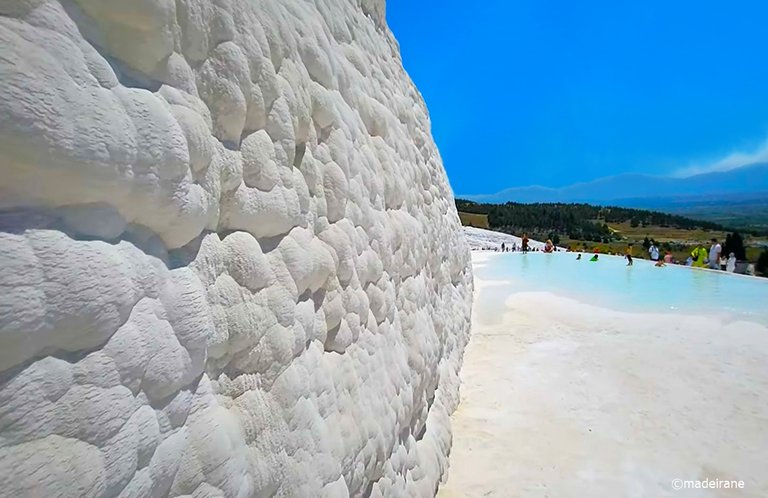
Tourists go down the mountain slope, because the most beautiful, clean, white travertines are there. But only a few reach the end; the majority stay on the upper terraces. The further we went down, the fewer tourists there were. Here you could calmly take a photo together as a keepsake. Only here do you understand why this amazing place was called the cotton castle.

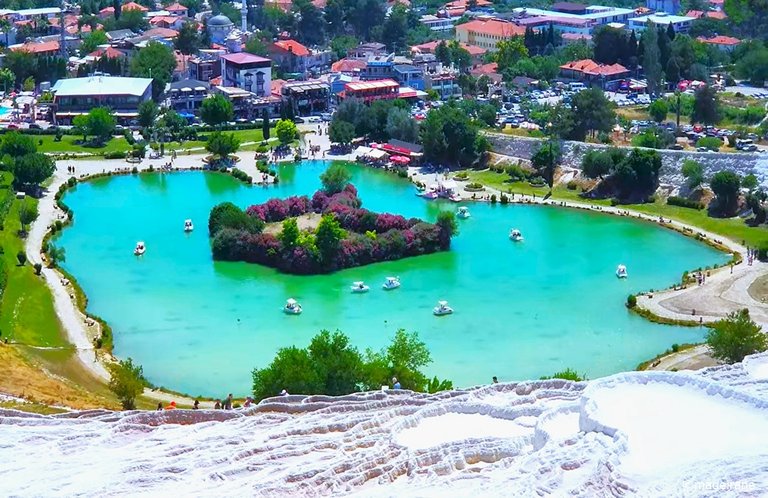
It was very hot, and the white color of the limestone travertine deposits attracts the sun's rays very strongly. It turns out that you can get sunburned not only when traveling on a pleasure yacht in the Mediterranean, but also here in Pamukkale. A long stay on the Pamukkale terraces is guaranteed to cause sunburn to your skin.
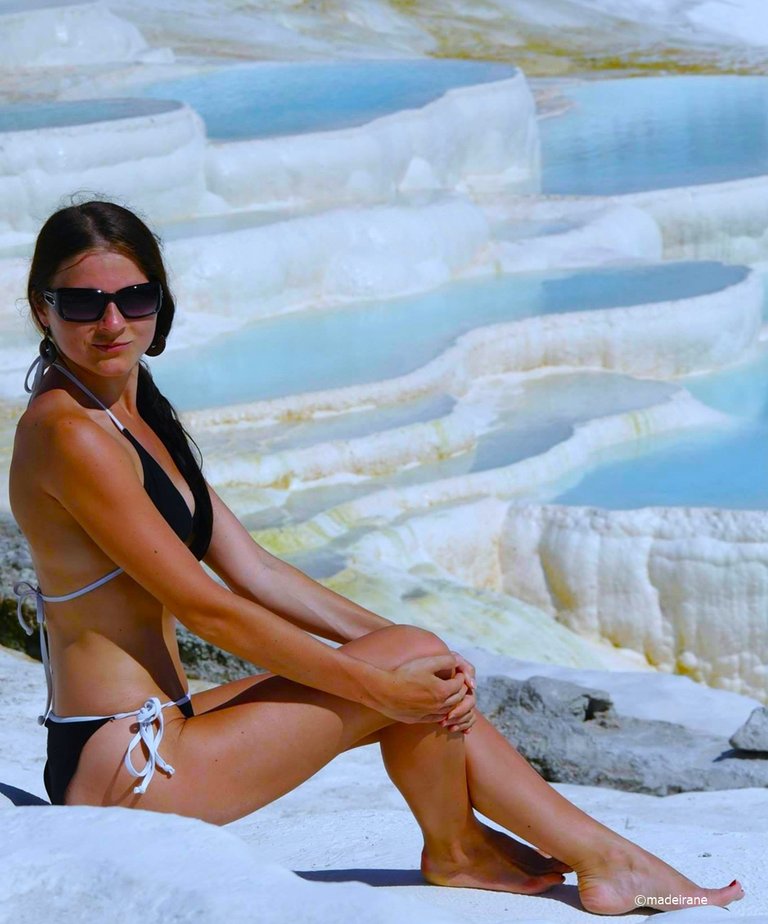
From the central square you get through the gate to another thermal spring, which is called Cleopatra's pool. According to legend, when Cleopatra's youth and beauty began to fade, she sent soldiers to find the magic water. They brought the water samples to her, and they had a strong effect to the skin. Cleopatra went to the place from where the water was brought. By her arrival, a pool with marble columns around it had been built. During another earthquake in 147 CE, some of the columns and slabs fell into the pool, and they still lie at the bottom of the pool.

Nowadays, tourists from all over the world come here to swim in the famous pool. The pool is not deep, about 1.5 m deep. Since the bottom of the pool is full of columns and slabs, you need to move very carefully. Moreover, to go further, you have to climb over obstacles.

What else is so good about this pool? Firstly, the unique composition of the water. The chemical composition of the water in Cleopatra's pool is very different from the water flowing down the slopes of Pamukkale. If there are only calcium salts there, then in Cleopatra's pool the water contains almost half of the periodic table.
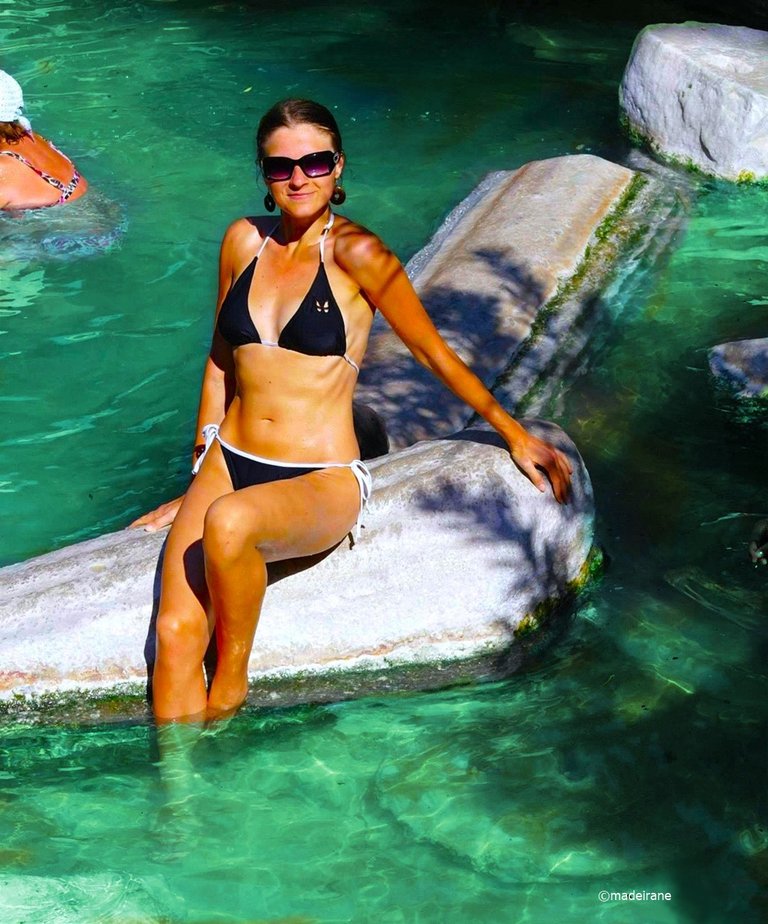
Secondly, the water temperature in the pool is 36.5 degrees all year round. Along a deep crack that formed as a result of an earthquake, hot water located near the magma gradually rises to the surface and cools down. On the surface, the temperature of the water from the springs is already 36.5 degrees. At this temperature, you can sit in the pool all day.

The pool is divided into two parts. Behind a small stone bridge there is a narrow part of the pool, similar to a canal, without any columns or slabs on the bottom. You can even swim here. And along the edges of the canal, through the holes in the slabs, water flows into the pool in the form of small waterfalls. Everyone tries to stand under the streams of water to massage their neck, shoulders and back.

And there is also an entrance to the very ancient city of Hierapolis. Excursions enter Hierapolis ancient city hrough the gates of the fortress wall. It once surrounded the city.Hierapolis means sacred city in Greek. It was built in 190 BC and destroyed by a powerful earthquake. During the Roman Empire, the city on travertines turned into an expensive resort. People came from all over the empire to the healing hot springs. At that time, Hierapolis flourished - a theater, stadium, baths, and fountains were built here.
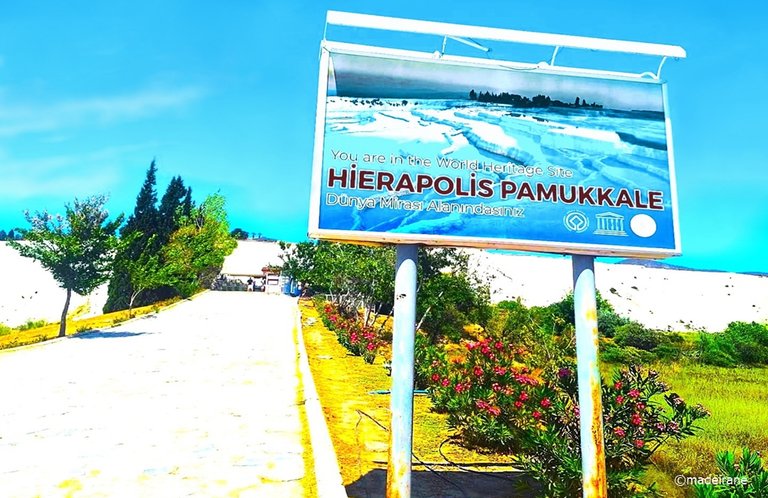
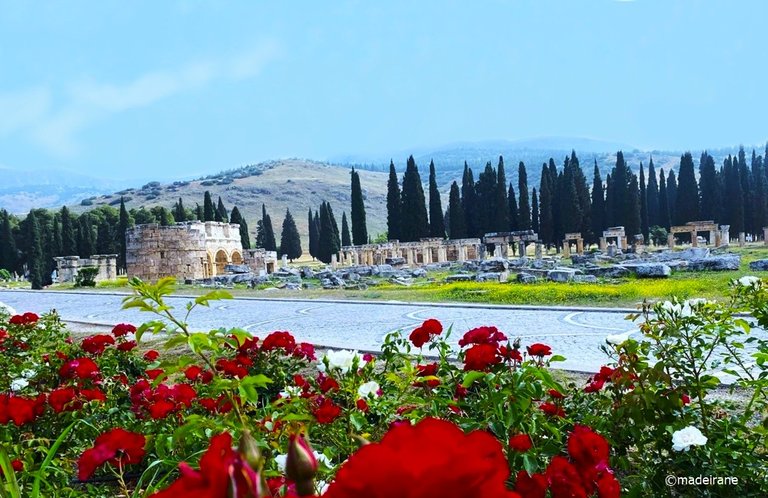
The amphitheater is perhaps the most grandiose structure of ancient Hierapolis. It was designed for 9.5 thousand spectators. The amphitheater was built by the Greeks. Its shape and architecture provided excellent acoustics.

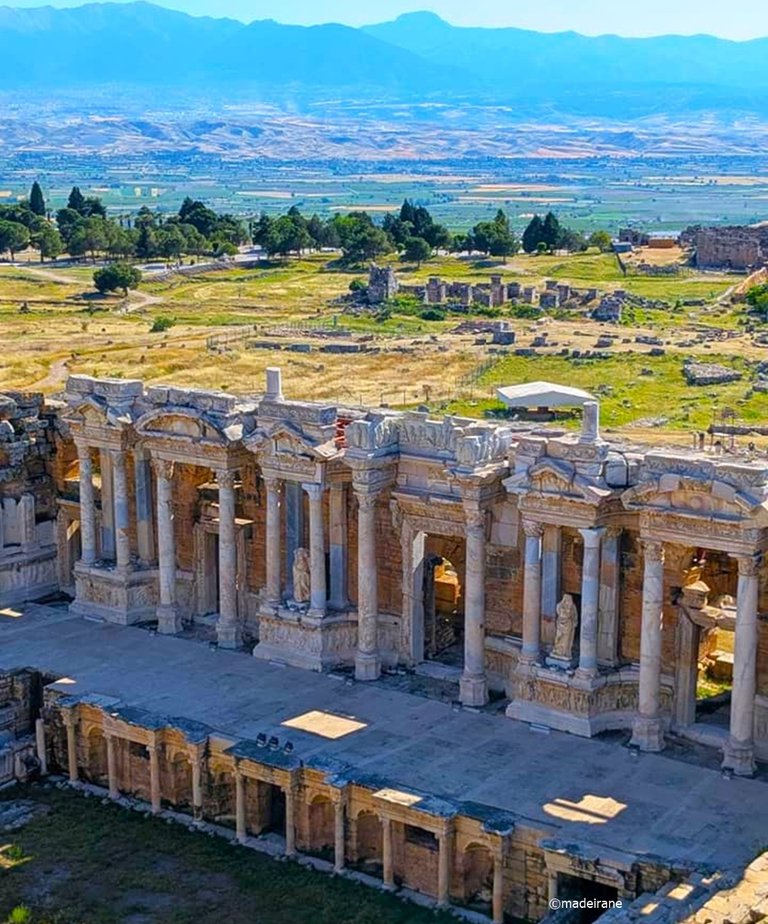
There are probably not so many such places on the globe, but visiting them will never leave anyone indifferent. All the emotions from what you have seen, and the unknown, will become complete and worthy of admiration only when you yourself can visit this truly unique and inimitable place. I mentioned some disadvantages of this trip, but they are not able to fence you off from the Pomukkale excursion.
.
💝💝💝💝💝💝💝💝💝💝
With love, @madeirane
Photos are taken by me.
© 2025
Translated from Lithuanian with DeepL.com (free version).
Kadangi apie Turkiją jau esu parašiusi keletą blogų, noriu pabandyti papasakoti, ką matėme per ankstesnius apsilankymus šioje nuostabioje šalyje. Ir, žinoma, pirmiausia tai Pamukalė.
Visada norime, kad bet kuri mūsų kelionė ilgus metus išliktų atmintyje. Visi žinome apie septynis pasaulio stebuklus. Bet kodėl tik septyni? Visame pasaulyje yra tik šios įdomios vietos, kurias galėtume vadinti stebuklais? Manau, kad jų yra kur kas daugiau. Ir viena iš jų yra Pamukalė Turkijoje. Tačiau yra vienas skirtumas.
Pasaulyje pripažinti pasaulio stebuklai buvo sukurti žmogaus rankomis ir būtent dėl šios priežasties priskiriami prie nepaaiškinamos kilmės kūrinių, besiribojančių su žmogaus galimybių riba. Žmogus yra neribotų galimybių kūrėjas. Vargu ar kas nors gali tai pakartoti dar kartą, tačiau tai, ką gali padaryti pati gamta, pagimdžiusi žmogų, yra nesuvokiama.
Pirmoji mano ekskursija Turkijos viduje buvo kelionė į neįtikėtinai gražią ir užburiančią vietą Denizli provincijoje, esančią už 250 km nuo Antalijos, paslaptingu ir viliojančiu aplankyti pavadinimu Pamukalė.
Pamukalė yra unikalus gamtos lobis, įtrauktas į UNESCO pasaulio paveldo sąrašą. Dėl šioje vietovėje esančių terminių šaltinių, kurių sudėtyje yra daug balto kalkakmenio (kalcio karbonato), kalva gavo nacionalinį pavadinimą - Medvilnės kalnas. Ši nežemiško grožio vietovė gali suteikti sveikatos ir nuo seno laikoma fantastiško egzotiško grožio mėgėjų kurortu. Šiuo metu Pamukalė yra labiausiai lankoma ir mėgstama visų tautybių turistų vieta, tačiau ne tik dėl savo unikalumo. Ši vieta garsėja iškart trimis lankytinomis vietomis vienoje nedidelėje teritorijoje, neskaitant Pamukalės - Kleopatros baseinu ir laiko bei istorinių įvykių sunaikintais senovinio Hierapolio miesto griuvėsiais. Neįmanoma perteikti įspūdžių apie tai, ką matėte gyvai.
Lankytinos vietos vieta nėra pati patogiausia turistams, ji gana toli nuo pajūrio kurortų pagal ekskursijų standartus, o tai sukelia nemažai nepatogumų ir trūkumų. Išvykstama anksti ryte, nes laukia ilgas kelias, o vidurdienį tvyro nepakeliamas karštis, nuo kurio galima gauti saulės smūgį, kelionė iki objekto ir atgal trunka apie 5-7 valandas, viskas priklausys nuo eismo spūsčių ir ekskursantų savijautos.
Turkai labai saugo ir globoja savo lankytinas vietas. Į ekskursiją gali vykti kiekvienas, bet be batų, basomis. Unikalumas to vertas. Manęs laukė kažkas nepaprastai gražaus ir užburiančio, užvaldančio dvasią. Neužtenka žodžių apibūdinti jausmams, kuriuos patyriau lankydamasis šioje nepakartojamo grožio ir unikalios kilmės vietoje. Kiekvieną kartą, kai žiūriu į šias nuotraukas, mane stebina gamtos didybė.
Vanduo kyla į paviršių iš 9 km gylio. Jame yra anglies dioksido ir kalcio druskų. Anglies dioksidas išgaruoja, o lieka baltos kalcio karbonato nuosėdos. Iš tikrųjų tai kalkių nuosėdos.
Pamukalės terasiniai tvenkiniai pagrįstai vadinami nevykusiu aštuntuoju pasaulio stebuklu. Artėjant prie jų iš tolo apima jausmas, kad tarp begalinės žalumos ant žemės guli tikras sniegas! Tarsi atsidūriau tarsi žiemos karalystėje, kurią sukaustė kaitri gegužės saulė. Vizualiai sniegas aplink tave po čiurlenančiais šaltiniais visai prilygsta šiems nuostabiems laukinės nevaržomos gamtos vaizdams.
Vanduo šioje atkarpoje teka praktiškai ištisine srove, o kuo žemiau leidiesi, tuo aiškiau ima ryškėti kalkakmenio klodai su melsvo atspalvio vandens telkiniais. Vanduo, kaip žinome, ardo akmenį, kuris čia taip pat atsispindi. Taisyklinga geometrinė telkinių forma žavi turistus savo grožiu.
Netrukus prieš mūsų akis atsivėrė gražiausi, kaip iš atviruko, apvalių terasų su stalaktitais pakraščiuose vaizdai. Koks grožis! Šios apvalios terasos yra kitoje pusėje nuo nusileidimo pradžios. Kai lankėmės Pamukalėje, dar galėjome į jas įeiti, bet dabar, kaip girdėjau, įėjimas į jas uždarytas, ir grožėtis jomis galima tik iš šono.
Paviršių dengiantis kalkių šlamas labai slidus, o daugybė kanalų, kuriais teka greiti upeliai, taip pat neleidžia jais judėti pėsčiomis. Dėl to jie yra nežemiško grožio. Jais galima grožėtis be galo. Kuo arčiau judate žemyn, tuo daugiau upelių yra paviršiuje.
Turistai leidžiasi kalnų šlaitu žemyn, nes ten yra gražiausi, švariausi, balti travertonai. Tačiau tik nedaugelis pasiekia galą, dauguma lieka viršutinėse terasose. Kuo toliau leidomės žemyn, tuo mažiau turistų buvo. Čia galėjai ramiai nusifotografuoti kartu atminimui. Tik čia supranti, kodėl ši nuostabi vieta buvo pavadinta medvilnės pilimi.
Buvo labai karšta, o baltos spalvos kalkakmenio travertino nuosėdos labai stipriai traukia saulės spindulius. Pasirodo, nudegti saulėje galima ne tik keliaujant pramogine jachta po Viduržemio jūrą, bet ir čia, Pamukalėje. Ilgas buvimas Pamukalės terasose garantuotai nudegins jūsų odą saulėje.
Iš centrinės aikštės pro vartus pateksite į kitą terminį šaltinį, vadinamą Kleopatros baseinu. Pasak legendos, kai Kleopatros jaunystė ir grožis ėmė blėsti, ji pasiuntė karius ieškoti stebuklingo vandens. Jie atnešė jai vandens mėginių, kurie stipriai veikė odą. Kleopatra nuvyko į vietą, iš kurios buvo atneštas vanduo. Jai atvykus, buvo pastatytas baseinas su marmurinėmis kolonomis aplink jį. Per kitą žemės drebėjimą 147 m. po Kr. kai kurios kolonos ir plokštės nukrito į baseiną ir iki šiol guli baseino dugne.
Šiandien turistai iš viso pasaulio atvyksta čia maudytis garsiajame baseine. Baseinas nėra gilus, maždaug 1,5 m gylio. Kadangi baseino dugnas pilnas kolonų ir plokščių, reikia judėti labai atsargiai. Be to, norėdami eiti toliau, turite įveikti kliūtis.
Kuo dar šis baseinas toks geras? Pirma, unikalia vandens sudėtimi. Kleopatros baseino vandens cheminė sudėtis labai skiriasi nuo Pamukalės šlaitais tekančio vandens. Jei ten yra tik kalcio druskų, tai Kleopatros baseine vandenyje yra beveik pusė periodinės elementų lentelės.
Antra, baseino vandens temperatūra visus metus yra 36,5 laipsnio. Palei gilų plyšį, kuris susidarė dėl žemės drebėjimo, karštas vanduo, esantis šalia magmos, pamažu kyla į paviršių ir atvėsta. Paviršiuje šaltinių vandens temperatūra jau yra 36,5 laipsnio. Tokios temperatūros baseine galima sėdėti visą dieną.
Baseinas padalytas į dvi dalis. Už nedidelio akmeninio tiltelio yra siaura baseino dalis, panaši į kanalą, be jokių kolonų ar plokščių ant dugno. Čia netgi galima plaukioti. O palei kanalo kraštus, pro skyles plokštėse, vanduo į baseiną teka nedideliais kriokliais. Visi stengiasi atsistoti po vandens srovėmis ir taip masažuoti kaklą, pečius ir nugarą.
Taip pat yra įėjimas į labai senovinį Hierapolio miestą. Į Hierapolio senovinį miestą ekskursijos patenka pro tvirtovės sienos vartus. Kadaise ji supo miestą. Graikų kalba Hierapolis reiškia šventąjį miestą. Jis buvo pastatytas 190 m. pr. m. e. ir sugriautas galingo žemės drebėjimo. Romos imperijos laikais miestas ant travertinų virto brangiu kurortu. Žmonės iš visos imperijos atvykdavo į gydomąsias karštąsias versmes. Tuo metu Hierapolis klestėjo - čia buvo pastatytas teatras, stadionas, pirtys ir fontanai.
Amfiteatras yra bene didingiausias senovės Hierapolio statinys. Jis buvo skirtas 9,5 tūkst. žiūrovų. Amfiteatrą pastatė graikai. Jo forma ir architektūra užtikrino puikią akustiką.
Tokių vietų pasaulyje tikriausiai nėra daug, tačiau apsilankymas jose niekada nepaliks abejingų. Visos emocijos iš to, ką matėte, ir nežinomybės taps pilnos ir vertos susižavėjimo tik tada, kai patys galėsite aplankyti šią tikrai unikalią ir nepakartojamą vietą. Paminėjau keletą šios kelionės trūkumų, tačiau jie nepajėgūs atbaidyti jus nuo Pomukalės ekskursijos.
You can check out this post and your own profile on the map. Be part of the Worldmappin Community and join our Discord Channel to get in touch with other travelers, ask questions or just be updated on our latest features.
Another place added to my bucketlist. I heard so much beautiful things abkut Turkey. And your post is new to me about Turkey. Amazingly beautiful place. Thanks for sharing your adventure. Have a great day. 🥰
The place is absolutely fabulous, I wish I could get here but so far I haven't had the opportunity, initially I was thinking to go by car but there are many kilometers from western Romania to get there, otherwise I remain with the desire to get there.
Delegate your Hive Power to Ecency and earn
100% daily curation rewards in $Hive!